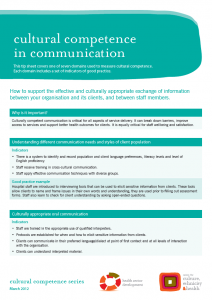How Can We Help?
How to support the effective and culturally appropriate exchange of information between your organisation and its clients, and between staff members.
Why is it important?
Culturally competent communication is critical for all aspects of service delivery. It can break down barriers, improve access to services and support better health outcomes for clients. It is equally critical for staff wellbeing and satisfaction.
Understanding different communication needs and styles of client population
Indicators
- There is a system to identify and record population and client language preferences, literacy levels and level of English proficiency.
- Staff receive training in cross-cultural communication.
- Staff apply effective communication techniques with diverse groups.
Good practice example
Hospital staff are introduced to interviewing tools that can be used to elicit sensitive information from clients. These tools allow clients to name and frame issues in their own words and understanding; they are used prior to filling out assessment forms. Staff also learn to check for client understanding by asking open-ended questions.
Culturally appropriate oral communication
Indicators
- Staff are trained in the appropriate use of qualified interpreters.
- Protocols are established for when and how to elicit sensitive information from clients.
- Clients can communicate in their preferred language/dialect at point of first contact and at all levels of interaction with the organisation.
- Clients can understand interpreted material.
Good practice example
A disability service trains all client service staff in working with interpreters. There is a centralised booking system for interpreters and processes for collecting feedback from staff and clients. Clients are provided with in-language information on interpreters and client files are marked with ‘interpreter required’ stickers to alert staff that an interpreter needs to be booked at each appointment.
Culturally appropriate written communication
Indicators
- Printed, online and audiovisual materials are appropriate to the literacy of target populations.
- Quality review mechanisms are established to check the integrity of translated materials.
- Culturally appropriate ways to disseminate written materials are identified.
- Clients understand written materials.
Good practice examples
A hospital discards its plan to translate its current nutrition booklet into Dinka, when it identifies that there are low literacy rates in this language amongst its target group. Instead, the dietitian meets with community representatives to explain the information in the booklet. She discovers that the content needs to be modified to address the group’s level of knowledge, beliefs and dietary practices. As a result the hospital produces a simple poster that uses pictorial information and culturally appropriate food items.
References
- This tip sheet is based on Indicators of Cultural Competence in Health Care Delivery Organisations: An Organisational Cultural Competence Assessment Profile , prepared by the Lewin Group Inc. under contract with the USA Department of Health and Human Services (2002).
- Refer to the CEH Language Services tip sheets for guidance on using interpreters: www.ceh.org.au/resources/publications.aspx
English Resource:
Last reviewed:
Links to the seven domains of the cultural competence framework
The eight tip sheets in this series cover different domains. These domains are interrelated and provide a comprehensive framework for assessing and improving cultural competence.
A framework for Cultural Competence
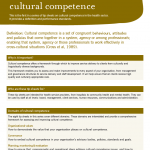
This is the first in a series of tip sheets on cultural competence in the health sector. It provides a definition and performance standards.
Governance

How to embed cultural competence in your organisation’s advisory bodies, policies, standards and goals.
Planning, monitoring & evaluation

How to ensure that programmatic and operational plans address cultural competence issues, and how to track and assess your organisation’s progress.
Communications
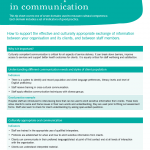
How to support the effective and culturally appropriate exchange of information between your organisation and its clients, and between staff members.
Staff development
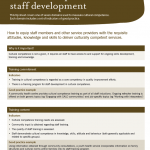
How to equip staff and service providers with the attitudes, knowledge and skills needed to deliver culturally competent services.
Organisational infrastructure
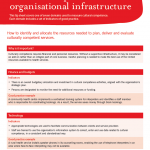
How to identify and allocate the resources needed to plan, deliver and evaluate culturally competent services.
Services & intervention
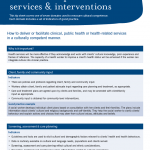
How to deliver or facilitate clinical, public health or health-related services in a culturally competent manner.
Organisational values
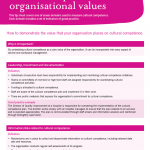
How to demonstrate the value that your organisation places on cultural competence.
Resource Type: Tip/Fact Sheets

